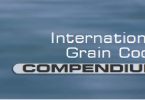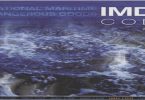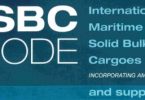1. General
- Have any changes been made or new equipment installed which would affect the validity of the BC Code certificate? Yes/No*
- Were all other Statutory Certificates and the Class Certificate valid at the time of survey? Yes/No*
- State names of cargo spaces in which solid bulk cargoes are to be loaded:
2. Documentation
- Is the approved ‘Loading Manual’ on board. Yes/No*
- Date of approval
- Approval Authority
- Is the approved “Trim and Stability Booklet” on board? Yes/No*
- Date of approval
- Approval Authority
- Is a copy of the latest edition of the BC Code on board, including all amendments? Yes/No*
3. List of Appendix ‘B’ cargoes required to be carried
- Applicable Cargoes
- Cargo UN. Number .
- B.C. Number
- IMO
- CLASS
Survey requirements
-
Sources of ignition
- Is all electrical equipment and cabling in the cargo spaces (including that associated with cargo space ventilation fans) and adjacent hazardous spaces or zones either:
- capable of being positively isolated, throughout the period during which the cargo is on board, from position(s) outside any hazardous space or zone, by removal of links or operation of lockable isolating switches or circuit breakers, or other effective means; or
- of a suitable certified safe type with all cable (with the permitted exception of that for intrinsically safe circuits) having a metallic braid or run in metallic conduit; or
- simple apparatus (e.g. thermocouple or similar temperature sensor, level switch with no electronic component, etc.) incorporated in an i-s circuit;—–
- (within the following locations only: ventilated spaces adjacent to a cargo hold, having access to the hold only via a self closing gastight door; on open deck, zones, or semi-enclosed spaces having an opening, within 3m of a cargo hold ventilation outlet) of type of protection ‘n’ or of a type not generating arcs or sparks in service and whose surface does not reach unacceptably high temperatures, or of a type otherwise offering protection against risk of ignition of gas?
- Is the electrical equipment of the types mentioned in note 1 above of Group II or IIC? —–
- Is the electrical equipment of the types mentioned in note 1 above of Group II, IIA, IIB or IIC? —–
- Is the electrical equipment of the types mentioned in note 1 above of temperature classification T1, T2, T3, T4, T5 or T6, or, in the case of 1(d), known to have a surface temperature not exceeding 450ºC?
- Is the electrical equipment of the types mentioned in note 1 above of temperature classification T2, T3, T4, T5 or T6, or, in the case of 1(d), known to have a surface temperature not exceeding 300ºC?
- Is the electrical equipment of the types mentioned in note 1 above of temperature classification T4, T5 or T6, or, in the case of 1(d), known to have a surface temperature not exceeding 135ºC?
- Is portable electrical equipment of a suitable certified safe type for exposure to atmospheres containing combustible gas, of Group and temperature classification as given in the previous notes (as applicable to the cargoes permitted to be carried)?
- Is all electrical equipment and cabling in the cargo holds (including that associated with cargo space ventilation fans) and in any space having a direct opening into a hold either:
- capable of being positively isolated, throughout the period during which the cargo is on board, from position(s) outside any hold or space with an opening into a hold, by removal of links or operation of lockable isolating switches or circuit breakers or other effective means; or
- of a type having ingress protection rating at least IP55 and surface temperatures not exceeding 200ºC (or assessed by a competent authority as suitable for use in the presence of combustible dusts), with all cable (with the permitted exception of that for intrinsically safe circuits) having metallic braid or armour, or run in metallic conduit? (Note: Certified safe type equipment having temperature classification T3, T4, T5 or T6 may be accepted, provided that it has ingress protection rating IP55, or better).
- Is portable electrical equipment of a type having ingress protection rating at least IP55 and surface temperatures not exceeding 200 deg. C, suitable for exposure to atmospheres containing combustible dusts (or assessed by a competent authority as suitable for use in the presence of combustible gas)?
- Is all electrical equipment and cabling in the cargo spaces capable of being positively isolated, throughout the period during which the cargo is on board, from position(s) outside any hold space, by removal of links or operation of lockable isolating switches or circuit breakers, or other effective means?
-
- Are all sources of ignition eliminated? —–
- Are there Prohibition Notices for welding, burning, cutting or other operations involving the use of fire, smoking, chipping and use of naked lights, or the introduction of other sources of ignition including the use of spark or arc producing equipment, posted in the vicinity of cargo spaces?
- Are workspaces (stores, workshops etc.) adjacent to the cargo spaces adequately ventilated?
-
- Can adequate surface ventilation be maintained? (Natural ventilation is sufficient)
- Are arrangements such that air is not directed into the body of the cargo?
-
- Are the cargo spaces ventilated by at least two separate fans? (A common ventilation system with 2 fans connected is acceptable)
- Is the total ventilation at least six air changes per hour, based on the empty space? —–
- Are the requirements of the Load Line Convention for openings not fitted with means of closure (i.e. height of ventilation inlets and outlets for mechanical ventilation arranged for continuous operation) complied with?
- Is good surface ventilation provided? (Natural ventilation is sufficient) —–
- Is ventilation such that any escaping gases cannot reach living quarters on or under the deck? —–
-
- Are the cargo spaces provided with mechanical ventilation?
- Are the requirements of the Load Line Convention for openings not fitted with means of closure (i.e. height of ventilation inlets and outlets for mechanical ventilation arranged for continuous operation) complied with?
- Are spark arresting screens fitted to ventilators? —–
- Is it possible to avoid cargo ventilation? (i.e. Can ventilators be completely closed?) —–
Temperature measurement
-
- Are means provided for measuring the temperature of the cargo in the range 0°C to 100°C? —–
- Do such arrangements enable the temperature of the cargo to be measured, while loading and during the voyage, without requiring entry to the cargo space?
- Are calibrated portable instruments, suitable for use from outside the cargo spaces, provided for measuring cargo temperature?
-
- Are means provided to enable the temperature to be taken throughout the cargo? —–
- Are the measurements recorded and is the information kept on board? —-
Gas detection
-
- Are there at least two suitable calibrated and certified explosimeters provided capable of detecting flammable gases?
- Are the measurements recorded and is the information kept on board?
-
- Is there a suitable calibrated and certified instrument provided to monitor for the presence of Oxygen and Hydrogen?
- Are such measurements taken at regular intervals throughout the voyage, recorded, and the information kept on board and made available on request?
- Is the instrument suitable for use in an inert atmosphere? —–
-
- Are there at least two suitable calibrated and certified detectors provided for quantitative measurements of Phosphine?
- Are the measurements recorded and is the information kept on board? –
-
- Are there at least two suitable calibrated and certified detectors provided for quantitative measurements of Arsine?
- Are the measurements recorded and is the information kept on board?
-
- Are there at least two suitable calibrated and certified detectors provided for quantitative measurements of Silane?
- Are the measurements recorded and is the information kept on board?
-
- Is there a suitable calibrated and certified detector provided to monitor for the presence of Hydrogen?
- Are the measurements recorded and is the information kept on board? –
-
- Is there a suitable calibrated and certified detector provided for quantitative measurements of Ammonia and Acetylene? —–
- Are the measurements recorded and is the information kept on board? —-
-
- Is there a suitable calibrated and certified detector provided for quantitative measurements of Hydrogen Sulphide, Sulphur Dioxide and Hydrogen Cyanide? —–
- Are the measurements recorded and is the information kept on board?
- Is there a suitable calibrated and certified detector provided for quantitative measurements of Methane and Carbon Dioxide?
-
- Is there a calibrated and certified instrument provided on board suitable for use from outside the cargo spaces for measuring:
- concentration of Methane in the atmosphere;
- concentration of Oxygen in the atmosphere;
- concentration of Carbon Monoxide concentration in the atmosphere?
- Is the instrument fitted with an aspirator, flexible connection and a length of tubing to enable a representative sample to be obtained from within the square of the hatch?
- Is the tubing stainless steel, approximately 0,5metres in length, and 6mm nominal internal diameter, with an integral stainless steel threaded collar? (The collar is necessary to provide an adequate seal at the sampling point.)
- Is a suitable filter provided to protect the instrument against the ingress of moisture? —–
- Are the sample results logged on a form that records cargo hold, date and time for each measurement? —
- Is there a calibrated and certified instrument provided on board suitable for use from outside the cargo spaces for measuring:
-
- Are two sampling points provided per hold (approximately 12mm in diameter), positioned as near to the top of the hatch coaming as possible, one on the port side, the other on the starboard side? (The sampling points should be as per amended BC Code)
- Is each sampling point sealed with a screw cap to prevent ingress of water and air?
- Are the arrangements fitted such that the watertight integrity of the ship is not compromised? —–
- Cargo spaces containing this product may become oxygen-depleted. Have notices to this effect, warning that precautions should be taken prior to entry, been prominently displayed in the cargo area?
- Are there calibrated and certified instruments suitable for use from outside the cargo spaces for measuring the concentration of Oxygen in the atmosphere?
Cargo stowage
- Are arrangements such that fertilizers of this type can be stowed out of direct contact with a metal engine-room boundary? (The use of flame-retardant bags containing inert materials or any equivalent barrier approved by the competent authority may be used).
- Has it been confirmed that fertilizers of this type are not stowed adjacent to any tank or double bottom containing fuel oil if such oil is heated to more than 50°C?
Cargo space integrity
- Are the bulkheads to the engine-room gastight? —–
- Has a pressure test been carried out to confirm that there is no leakage of manholes or piping systems from fuel tanks situated under, or leading through, the cargo spaces in which this cargo is to be loaded?
- Are the boundaries of the cargo spaces where this cargo is carried resistant to fire and water? —–
- Are protective clothing, dust-masks and goggles provided on board? (For solid bulk cargoes the protective clothing is to satisfy the equipment requirements specified in Appendix E of the BC Code for the individual substances, which states that, ‘protective clothing varies in its resistance to various chemicals and the clothing provided should be suitable for the substances being carried. The manufacturer’s recommendations concerning suitability for various materials should be followed. Other clothing of reasonable thickness does, however, afford some protection, even if the cloth itself may be attacked.’)
- Are there at least two self-contained breathing apparatuses provided additional to those required by Ch II-2, Regulation 17 or 10.10 of the 1974 SOLAS Convention, as amended?
Hold bilge arrangements
- Can appropriate precautions be taken to avoid penetration of the cargo into other cargo spaces, bilges, etc.?
- Have means been provided in the cargo hold bilge arrangements to ensure against inadvertent pumping through the engine-room?
- Can appropriate precautions be taken to avoid penetration of the cargo into bilges, wells or between ceiling boards? —–
-
- Are means provided for measuring pH values of hold bilge samples? —–
- Do such arrangements enable the pH values to be measured, while loading and during the voyage, without requiring entry to the cargo space?
Atmosphere control
- Is the ship equipped with facilities for introducing Carbon Dioxide or another inert gas into the cargo spaces, if the voyage exceeds five days? (Note: It is suggested that the quantity of Carbon Dioxide to be carried for topping-up purposes is 5% of the gross volume of the holds in which the cargo is to be carried. A cock or valve should be fitted to each hold where Carbon Dioxide may be introduced. The piping system need not be of a permanent nature. It should not be connected to the Carbon Dioxide fire fighting system.)
- Can the cargo spaces be maintained throughout the voyage under an inert atmosphere containing less than 5% oxygen and less than 1% by volume hydrogen? (This is required where the substance has not been manufactured or treated with an oxidation and corrosion inhibiting process which has been proved to provide effective protection against dangerous reaction with sea water or air under shipping conditions)
Fire containment/extinction
-
- Are there adequate supplies of water for fire-fighting purposes immediately available from the fire main whenever this cargo is on board?
- In case this cannot be supplied by the ship’s pumps, is capacity increased to the required amount by means of portable pumps?
- If cargo is carried adjacent to the engine-room, is the bulkhead between the cargo space and the engine-room insulated to Class ‘A-60’ standard? —–
- Is a fixed gas fire-extinguishing system provided, in accordance with 1974 SOLAS Chapter II-2, regulation 53.1.2 or 10.7.2? —–
- Is it confirmed that the briquette cargo is not stowed adjacent to hot areas? —–
Dangerous Goods
This cargo is classed as dangerous goods under 1974 SOLAS Ch VII, regulation 2, and compliance with 1974 SOLAS Ch II-2, Regulation 54/19 may be required for its carriage.Regulation 54/19 is a mandatory requirement for a ship carrying, or intending to carry, dangerous goods as defined in 1974 SOLAS Ch VII, regulation 2, except class 6.2 and 7, and is:



